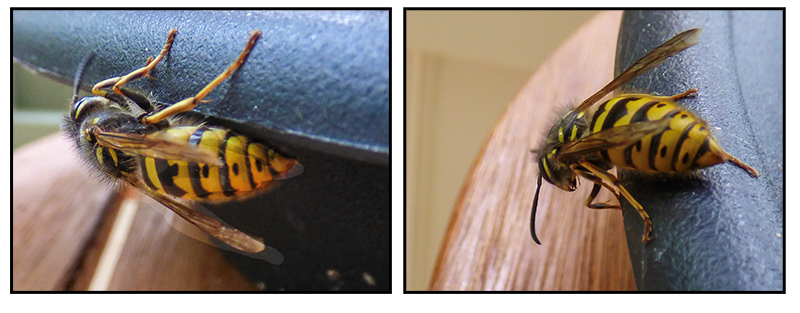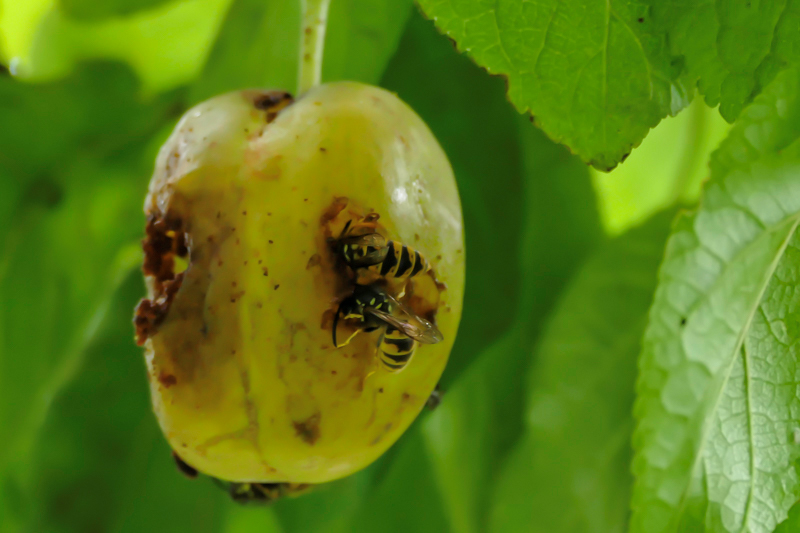

Home
About Us
Allotments
Garden Equipment
Seed Suppliers
Manure Problems
Children's Pages
GLA Blog
Weather Blog
School Veg Patch
Useful Links
Wasp
There are many species of what scientists refer to as wasps but when most gardeners refer to wasps they will generally be referring to the group of social wasps. Social insects are those which live in a group in nests and work together co-operatively to rear young.
There are six species of social wasps (seven if you count the Cuckoo Wasp which lays its eggs in the nests of other species!) found in Britain and of these the ones that gardeners are most likely to come across are the Common wasp and the German wasp. If you dare get close enough to try and identify a particular wasp then click here for a web site that may help. I think the wasps in the photos and video on this page are German wasps.
As you would imagine the Common wasp is the most common! Both types of wasps wear the typical yellow and black stripes and have yellow legs and black antennae – the difference between the two species is in the detail. Yellow and black stripes are a common defence mechanism that warn creatures that would otherwise try to eat them that they are poisonous or taste unpleasant. Some harmless insects such as hoverflies cash in on this and pretend to be poisonous by wearing the same coloured outfit!

Wasps’ nests are built in a sheltered place which can at times put the insect’s interests in conflict with those of the gardener or home owner. We have come across wasps’ nests in our garage, (as shown in the photograph on the bottom left above), in our roof space, in our wall cavity and my sister has had an incidence of a wasp building its nest on top of her wardrobe! In the garden we have found wasps’ nests in the straw used to protect overwintering plants and in compost heaps. The two photos at the top of the collage above were found in the middle of our compost heap.
On one occasion I inadvertently trod on a wasps’ nest whilst picking redcurrants. The nest had been built in a hole in the ground among the bushes. This situation was compounded by the fact that I was under a fruit-cage net at the time and couldn’t make as quick a retreat as I would have liked. The first that I knew was a stinging sensation on my foot. When I looked down a group of wasps were surrounding my foot in attack mode.
I suppose in retrospect I was fairly lucky as a nest can house huge numbers of individuals – commonly up to 10,000 workers. When a nest is under threat, as this mob perceived theirs was, and one of the wasps decides to sting a chemical signal is sent out to all the other wasps to join in the attack. The wasps will continue to sting until they sense that the threat to the nest has passed. Unlike bees wasps can sting repeatedly. It is in fact only the female wasp that can sting but seeing as most of the wasps that you are likely to come into contact with are female then this is no consolation.
Wasps however, don’t sting through malice and are programmed only to sting if they or their nest is threatened so generally speaking keeping them at a distance is the best advice. Often we trigger the defence actions by waving arms around to waft them away or as I did accidentally threatening them or their nest.
The large wasps that you see in spring are likely to be fertile young queens in search of an ideal nesting place in which to begin their colony.
Once a suitable site has been found the queen will begin to build a small nest – like the one in the earlier photograph. Wasps build their nests by producing a papier-mậché type of substance. They find a source of wood – sometimes a garden fence and scrape shavings of wood from it using their moth parts.
If you listen carefully you can hear the scraping. If they have been at work on your fence you are likely to notice vertical scratch marks on it. Once sufficient wood shavings have been collected, the wasp mixes it with saliva and uses the resulting paper-like substance to build the nest.

The queens will build a small nest containing up to 20 hexagonal cells. In each cells she will lay and egg. Once they have hatched she will feed the grubs for about a month after which they will pupate. From the pupae new worker female worker wasps will emerge. After this point the queen’s only task is to lay eggs. The workers will continue increasing the size of the nest, will defend it from attack, keep it cool in summer by fanning their wings and will look after and feed the grubs.
The workers in many ways can be considered to be a gardeners’ friend. The grubs are meat eaters and the worker wasps feed them an enormous amount of insects and caterpillars. The workers paralyse their prey by stinging them and then mash up the insects to a pulpy ball before feeding them to the grubs.
Adult wasps do not have the same diet and rely mainly on nectar or other sugary substances. One such substance is produced as waste by the grubs, so in effect the grubs and adults feed each other. Once the grubs have pupated and new worker wasps will add to the colony number and continue building up the size of the colony.
Towards the end of the summer special larger cells are constructed. The eggs laid in these cells will develop into fertile male wasps and young queens. Once these wasps leave the nest the workers no longer have a purpose.
They will leave the nest and become more interested in searching out sweet substances on which to gorge themselves. It is at this point that they become a nuisance to us and often damage fruit crops. It is also a time when the wasps may come in closer proximity to us in their search for sweet sticky things and we are more likely to be stung.

Picking plums on our plot can be a hazardous task and as the photograph shows the wasps are also partial to our red apples. While the redundant workers think only of food, the young queens and males have other things on their minds. They have to find a mate before the weather turns cold.
As wasps do not have the ability to store food, once the weather becomes cold and a ready supply of food is no longer available, all except for the larger young – now fertile – queens will die. The young queens will find a safe underground location in which to hibernate until spring when the whole process will start again.
Our Plot at Green Lane Allotments Blog | A Gardener's Weather Diary | School Vegetable Patch Website
© Our Plot on Green Lane Allotments - Please email me if you wish to use any of this site's content